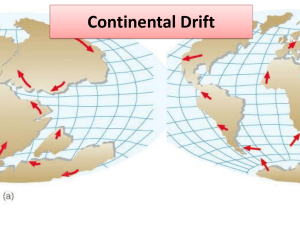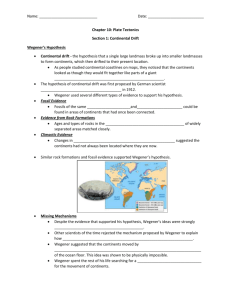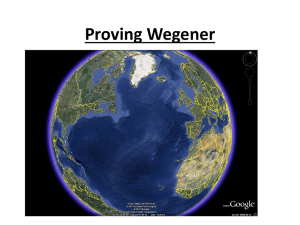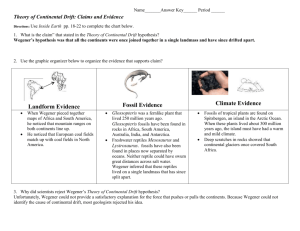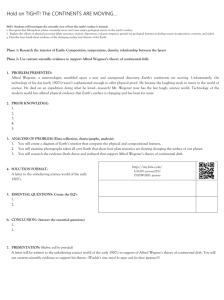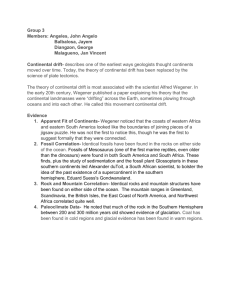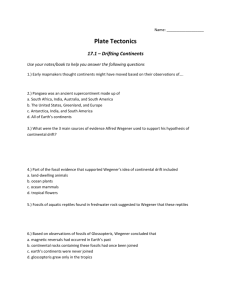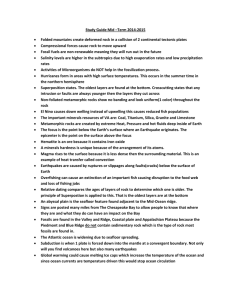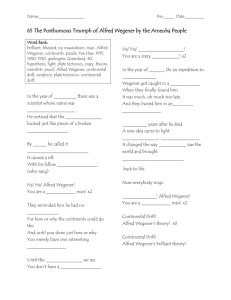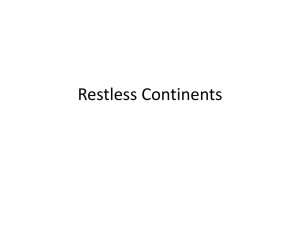EQ: What was Wegener`s hypothesis of continental drift and how
advertisement
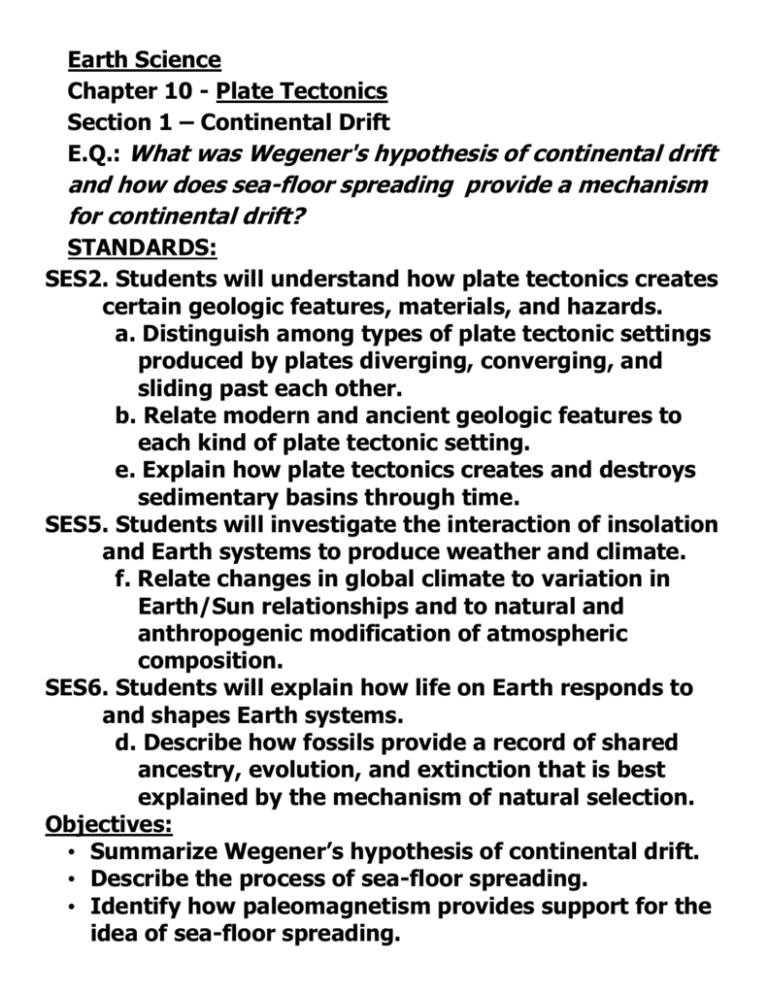
Earth Science Chapter 10 - Plate Tectonics Section 1 – Continental Drift E.Q.: What was Wegener's hypothesis of continental drift and how does sea-floor spreading provide a mechanism for continental drift? STANDARDS: SES2. Students will understand how plate tectonics creates certain geologic features, materials, and hazards. a. Distinguish among types of plate tectonic settings produced by plates diverging, converging, and sliding past each other. b. Relate modern and ancient geologic features to each kind of plate tectonic setting. e. Explain how plate tectonics creates and destroys sedimentary basins through time. SES5. Students will investigate the interaction of insolation and Earth systems to produce weather and climate. f. Relate changes in global climate to variation in Earth/Sun relationships and to natural and anthropogenic modification of atmospheric composition. SES6. Students will explain how life on Earth responds to and shapes Earth systems. d. Describe how fossils provide a record of shared ancestry, evolution, and extinction that is best explained by the mechanism of natural selection. Objectives: • Summarize Wegener’s hypothesis of continental drift. • Describe the process of sea-floor spreading. • Identify how paleomagnetism provides support for the idea of sea-floor spreading. • Explain how sea-floor spreading provides a mechanism for continental drift. Wegener’s Hypothesis • Continental drift the hypothesis that states that the continents once formed a single landmass, broke up, and drifted to their present location • The hypothesis of continental drift was first proposed by German scientist Alfred Wegener in 1912. • Wegener used several different types of evidence to support his hypothesis Wegener’s Evidence • Fossil Evidence: fossils of the same plants and animals could be found in areas of continents that had once been connected. • Evidence from Rock Formations: ages and types of rocks in the coastal regions of widely separated areas matched closely. • Climatic Evidence: changes in climatic patterns suggested the continents had not always been located where they are now. Similar rock formations and fossil evidence supported Wegener’s hypothesis. Missing Mechanisms • Wegener proposed that the continents moved by plowing through the rock of the ocean floor. • Wegener’s ideas were strongly opposed. • Wegener’s mechanism was disproved by geologic evidence. • Wegener spent the rest of his life searching for a mechanism for the movement of continents. Reading Check Answer Why did many scientists reject Wegener’s hypothesis of continental drift? Many scientists rejected Wegener’s hypothesis because the mechanism that Wegener suggested was easily disproved by geologic evidence. Mid-Ocean Ridges • Mid-ocean ridge a long, undersea mountain chain that has a steep, narrow valley at its center, that forms as magma rises from the asthenosphere, and that creates new oceanic lithosphere (sea floor) as tectonic plates move apart In 1947, a group of scientists set out to map the MidAtlantic Ridge. While studying the Mid-Atlantic Ridge, scientists noticed two surprising trends. 1. The sediment that covers the sea floor is thinner closer to a ridge than it is farther from the ridge 2. The ocean floor is very young. Rocks on land are as old as 3.8 billion years. None of the oceanic rocks are more than 175 million years old. Rocks closer to a mid-ocean ridge are younger than rocks farther from the ridge. Rocks closer to the ridge are covered with less sediment than rocks farther from the ridge. Sea-Floor Spreading • Sea-floor spreading the process by which new oceanic lithosphere (sea floor) forms as magma rises to Earth’s surface and solidifies at a mid-ocean ridge • Paleomagnetism the study of the alignment of magnetic minerals in rock, specifically as it relates to the reversal of Earth’s magnetic poles; also the magnetic properties that rock acquires during formation • In the late 1950’s geologist Harry Hess proposed that the valley at the center of the mid-ocean ridge was a crack, or rift, in Earth’s crust. • As the ocean floor moves away from the ridge, molten rock, or magma, rises to fill the crack. • Hess suggested that if the sea floor is moving, the continents might be moving also. • He suggested this might be the mechanism that Wegener was searching for. As the ocean floor spreads apart, magma rises to fill the rift and then cools to form new rock. Reading Check How does new sea floor form? New sea floor forms as magma rises to fill the rift that forms when the ocean floor moves away from a midocean ridge. Paleomagnetism Paleomagnetism the study of the alignment of magnetic minerals in rock, specifically as it relates to the reversal of Earth’s magnetic poles; also the magnetic properties that rock acquires during formation As magma solidifies to form rock, iron-rich minerals in the magma align with Earth’s magnetic field. When the rock hardens, the magnetic orientation of the minerals becomes permanent. Magnetic Reversals • Scientists have discovered rocks whose magnetic orientations point opposite of Earth’s current magnetic field. • Rocks with magnetic fields that point north (normal polarity) are all classified in the same time periods. • Rocks with magnetic fields that point south (reversed polarity) also all fell into specific time periods • When scientists placed these periods of normal and reversed polarity in chronological order, they discovered a pattern of alternating normal and reversed polarity in the rocks. • Scientists used this pattern to create the geomagnetic reversal time scale. Magnetic Symmetry • Scientists discovered a striped magnetic pattern on the ocean floor on each side of a mid-ocean ridge. • The pattern on one side of the ridge is a mirror image of the pattern on the other side. • When drawn on a map, these patterns match the geomagnetic reversal time scale. • Magnetic Symmetry The pattern of magnetic symmetry and age of rock formation indicate that new rock forms at the center of a ridge and then move away from the center in opposite directions. Reading Check How are magnetic patterns in sea-floor rock evidence of sea-floor spreading? The symmetrical magnetic patterns in sea-floor rocks show that rocks formed at one place (at a ridge) and then broke apart and moved away from the center in opposite directions. Wegener Redeemed • Reversal patterns on the sea floor could also be found on land. The reversals in land rocks also matched the geomagnetic reversal time scale. • Because the same pattern appears in rocks of the same ages on both land and the sea floor, scientists agreed that the magnetic patterns showed change over time. • The idea of sea-floor spreading provides a way for the continents to move over the Earth’s surface. • Sea-floor spreading was the mechanism that verified Wegener’s hypothesis of continental drift.
